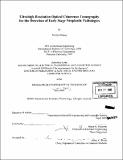Ultrahigh resolution optical coherence tomography for the detection of early stage neoplastic pathologies
Author(s)
Hsiung, Pei-Lin, 1975-
DownloadFull printable version (29.04Mb)
Other Contributors
Massachusetts Institute of Technology. Dept. of Electrical Engineering and Computer Science.
Advisor
James G. Fujimoto.
Terms of use
Metadata
Show full item recordAbstract
Identification of changes associated with early stage disease remains a critical objective of clinical detection and treatment. Effective screening and detection is important for improving outcome because advanced disease, such as metastatic cancer, can be difficult to impossible to cure. Many existing diagnostic modalities, including x-ray imaging, magnetic resonance imaging, ultrasound, and endoscopy do not have sufficient resolution to detect changes in architectural morphology associated with early neoplasia and other pathologies. Diagnostic modalities capable of identifying pre-malignant tissue at an early stage could therefore significantly improve treatment outcome. Optical coherence tomography (OCT) is an emerging biomedical imaging technique that can potentially be used as an in vivo tool for identifying early stage neoplastic pathologies. Recent advances in solid-state laser and nonlinear fiber technology have enabled the development of ultrahigh resolution and spectroscopic OCT techniques which promise to improve tissue differentiation and image contrast. Previous ex vivo, benchtop ultrahigh resolution OCT imaging studies suggest that differentiation of architectural morphology associated with pathology is feasible. This thesis covers the development and investigation of ultrahigh resolution OCT for studies of early neoplastic pathologies. (cont.) A section of this thesis will focus on development and evaluation of a novel turn-key broadband source for OCT. Feasibility studies were performed using ultrahigh resolution OCT for imaging human tissues ex vivo in the clinical pathology laboratory setting. Imaging results will be presented examining a variety of normal and neoplastic lesions in preliminary studies of the thyroid gland, large and small intestine, and breast. These experiments elucidate the optimal imaging parameters, potential and limitations of the technique, and establish the microstructural markers visible in OCT images that are characteristic of pathologic tissues. These studies establish a baseline which should help interpret future in vivo ultrahigh resolution OCT imaging studies.
Description
Thesis (Ph. D.)--Massachusetts Institute of Technology, Dept. of Electrical Engineering and Computer Science, 2005. Includes bibliographical references (p. 105-118).
Date issued
2005Department
Massachusetts Institute of Technology. Department of Electrical Engineering and Computer SciencePublisher
Massachusetts Institute of Technology
Keywords
Electrical Engineering and Computer Science.